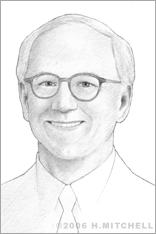Paul Yock
Medical technologies, such as those created by physician and inventor Paul G. Yock, have helped to revolutionize patient care around the world. Doctors and surgeons have in recent decades gained unprecedented access to advanced devices and techniques that have saved or extended thousands of lives and promise to help millions more.
Some of the most important and commonly used devices are those employed in the field of cardiology, especially in the area of angioplasty. Yock’s work on systems such as the Rapid Exchange balloon angioplasty/stenting system, and the Smart Needle, have made it possible for doctors to better diagnose and treat blocked arteries, which can lead to stroke, heart attack and in many cases, death.
Yock was born on March 17, 1951 in Minneapolis, Minnesota. A bright student, he entered Amherst College in Massachusetts in 1969, where he double majored in chemistry and philosophy and served as president of the Amherst chapter of Phi Beta Kappa. He graduated in 1973, summa cum laude.
From there Yock went on to study philosophy and physiology at Oxford University, where he earned an M.A., Oxon, in 1975. He returned to the United States that year to enter medical school at Harvard, where he completed his M.D. in 1979.
Medical training commenced that year with his internship at the University of California, San Francisco, where he also completed his medical residency in 1982. He began a Fellowship in Cardiology at Stanford University Medical Center and finished in 1985, moving on to a Fellowship in Coronary Angioplasty at Sequoia Hospital in Redwood City, Calif.
After returning briefly to Stanford, he went back again to UCSF where he served as an Assistant Professor, and later Associate Professor, of Medicine in the area of Cardiology from 1986 to 1994. That year he joined the Stanford University School of Medicine’s Cardiovascular Medicine division as an Associate Professor of Medicine, where he has remained and has held a variety of positions as of this 2006 writing, including Acting Chief, and later Associate Chief, of the Cardiovascular Medicine division, Professor of Medicine, and, as of 2000, Martha Meier Weiland Professor of Medicine. He also became co-chair in 2001 of Stanford University’s newly designed program in Bioengineering.
Meanwhile, Yock has built an impressive body of work in a number of areas, with a focus on building and commercializing devices for use in the operating room. His first patent was awarded in 1988, when he and a colleague received U.S. Patent No. 4,748,982 for a “Reinforcing balloon dilatation catheter with slitted exchange sleeve and method.” More than 35 additional patents followed, for a variety of medical devices and processes, and others are pending.
He may be most well known for his creation of the Rapid Exchange balloon angioplasty/stenting system, which has become the basis for the most common method for performing angioplasty/stenting in the world. However, he is credited with a variety of other groundbreaking advances as well. His authorship of fundamental patents for intravascular ultrasound imaging lead to his founding Cardiovascular Imaging Systems, now a division of industry giant Boston Scientific as a result of a $100 million acquisition in 1994. His ultra-sound-guided “Smart Needle” device helps doctors insert a needle into the correct passage with its ability to “listen” for blood flow. Yock’s intravascular ultrasound device lets doctors take photographs of arteries from the inside so that they can easily detect areas where plaque buildup is present.
Additionally, Yock, who also serves as the Martha Meier Weiland Professor in the School of Medicine and Professor in the School of Medicine and Professor of Bioengineering and Mechanical Engineering at Stanford School of Medicine, developed the Medical Device Network in 1998. This program, based at Stanford but which is collaborative among departments and among other universities, is designed to support and guide biomedical technology innovation. The organization spawned a new entity, known as the Stanford Program in Biodesign, a unit of Bio-X dedicated to advancing training in medical technology innovation, which Yock also directs.
In addition to his leadership roles, Yock has also authored hundreds of articles as well as a textbook. He is an active member of the American Heart Association, the American Society of Echocardiography, the American Association for the Advancement of Science and a number of other national organizations as well as academic groups, at Stanford and elsewhere, including UCSF. He continues to work on advancing medical technology for the field of cardiology.


